A while ago I came across the work of Jonathan Edelman, whose main research is on design team behavior. He specifically looks at how different media influences behavior and team performance but comes up with some other concepts, which I feel can be rewarding for you.
Jonathan used to be with the Stanford Center for Design Research and is now the Head of Programme for Global Innovation Design at the Royal College of Art, London. He is a brilliant observer and I feel like I can learn a lot from his work.
The main document about his research is probably his dissertation, which you can download for free from the Stanford Digital Repository [1]. You don’t have to do this, because I will tell you about his most important findings right now and also draw some implications from them. But if you want to dig deeper, you will have the chance to do that.
Jonathan basically video-taped design teams of three students in small group meetings working on a redesign for a “Material Analyzer”. Afterwards he would transcribe and closely analyze the videos to make sense of what people are doing when they do design. He was initially interested in how different types of media such as blueprints, rough and detailed prototypes would impact the outcome of these sessions but soon took a broader interest in behavioral design patterns. Before we start, I should mention that Jonathan’s work is qualitative, which in this case means that he dived into his material (the video-recordings) without a specific preconception of what the outcome should be. This approach can be very rich in findings but lacks a (quantitative) generalizability.
So what did he find out? The findings can be split up into three main aspects:
First, Jonathan came up with a framework which would allow him to differentiate between different depths of engaging with the problem (of redesigning the material analyzer) he posed to the students. Jonathan calls these “dimensions of engagement”. The framework implicates that designers engage with problems on two different levels, one being the “object” itself (which can of course be any type of entity such as a product, service or strategy) and the other one the “world” around it. You can find the “dimensions of engagement” and examples specific to the material analyzer in the table below.
For example, a design team might redesign the surface of an object by discussing the necessity or arrangement of buttons
Not surprisingly, those teams whose statements, lists, sketches, and gestures (which Jonathan counted and categorized) indicated towards deeper levels of redesign, derived further from the original design than others. Nevertheless, teams who chose to work in shallower fields, were able to optimize the product.
Second, Jonathan looked at how different kinds of media might influence team interactions (entitled “media response and interaction”). He eventually differentiates between two behavior classes, namely anchoring and scaffolding. (These terms derived from improvisational theater.) While anchoring happens when designers block somebody else’s suggestions using the media they work with, scaffolding happens when suggestions are built upon, using the media they work with.
I am including pictures of the media (prototypes) that the teams received below. While the cardboard puck and the experience-like model are both poorly defined, the foam model is well defined. What differentiates the former two is their abstraction levels: The experience-like model is more concrete than the cardboard. (If you are curious about the underlying media models framework, you can read about it in chapter 1.4.5 of Jonathan’s dissertation.)
Interestingly, the teams that received experience-like models rather used it for scaffolding, while teams with a foam model used it for anchoring. Teams who received a cardboard puck did not use it for either.
Third, Jonathan looked at how designers move through “perceptual landscapes”, i.e. which ideas they consider and/or follow. For that, he coins the terms wayfinding and navigation, subordinated under “path determination”. While wayfinding means finding one’s path by following “direct perceptual cues”, navigators follow a predefined path, usually the shortest one possible. This implicates that wayfinders take longer to get to the goal, but also see more of the landscape they pass.
Now for me, the most important result of Jonathan’s study is the connection and interpretation of these three aspects: dimensions of engagement, media response and interaction, and path determination. This is partly done within the “innovation behavior framework” shown below.
What it basically says is, that teams who
- engage with worlds and objects on a deeper level
- use media to scaffold, i.e. to build upon one another’s ideas
- find their way through the design process by following perceptional cues rather than following a pre-defined path
are likely to bring about radical breaks. For incremental improvements, which can be very rewarding at certain times of the design process as well (think about polishing up your product before a deadline), it is the other way around.
So what does all of this mean for your work?
I’d like to finish off with some calls to action to support radical breaks that directly derive from Jonathan’s work.
– Use edgy prototypes that do not seem to be almost finished!
– Use prototypes that focus on the user experience!
– Push yourselves to scrutinize presumptions and dig deeper.
– Think about the core functionalities and the greater context of your product!
– Build upon each other’s ideas rather than blocking them!
Can you relate to some of Jonathan’s findings? What would you want to question? Let me know your thoughts in the comments section below!
[1] Edelman, Jonathan Antonio. 2011. “Understanding Radical Breaks: Media and Behavior in Small Teams Engaged in Redesign Scenarios.” Stanford University.
[2] Buchenau, Marion, and Jane Fulton Suri. 2000. “Experience Prototyping.” In Proceedings of the 3rd Conference on Designing Interactive Systems: Processes, Practices, Methods, and Techniques, 424–33. DIS ’00. New York, NY, USA: ACM.


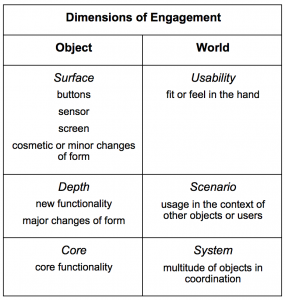
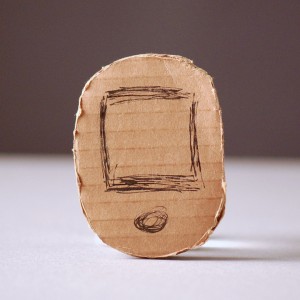
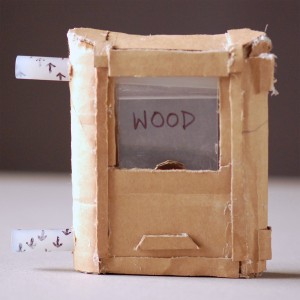
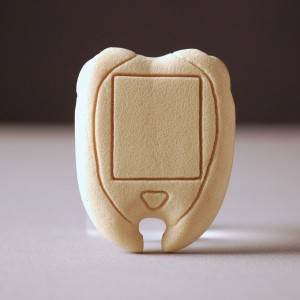
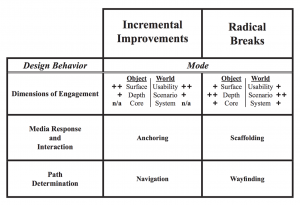
Leave a Reply